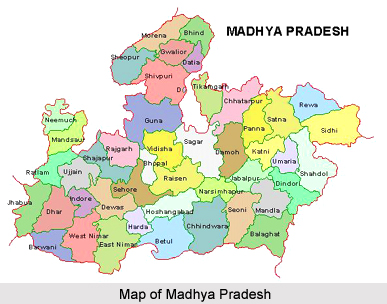 Demography of Madhya Pradesh indicates that tribal population inhabits the largest portion of the total area of the state. Population is considered as the major component of nature and its ecosystem. Equally, it plays a vital and integrated role in the process of all round development. The population of Madhya Pradesh is 7, 25, 97,565 million (2011 census), an increase of 24.34% . The population density is 196 people per square kilometer. More than 75% of state population resides in villages whose main occupation is agriculture, while the rest of the population lives in towns. Indore district is the most populated one. Number of females per thousand male (sex ratio) in the state is 919 where as the literacy rate is 63.70%.
Demography of Madhya Pradesh indicates that tribal population inhabits the largest portion of the total area of the state. Population is considered as the major component of nature and its ecosystem. Equally, it plays a vital and integrated role in the process of all round development. The population of Madhya Pradesh is 7, 25, 97,565 million (2011 census), an increase of 24.34% . The population density is 196 people per square kilometer. More than 75% of state population resides in villages whose main occupation is agriculture, while the rest of the population lives in towns. Indore district is the most populated one. Number of females per thousand male (sex ratio) in the state is 919 where as the literacy rate is 63.70%.
Demography of Madhya Pradesh further suggests that with the various ethnic groups of the central Indian tribal stock, this state presents a miniature model of vivid and varied picture of the tribal ways of life and culture. Prominently, the south and the southeastern regions of Madhya Pradesh have the biggest concentration of tribal population. It is considered as an expansion of the principal tribal habitation zone of central India. The major tribes of Madhya Pradesh are Gond tribe, Korku tribe, Saharia tribe, Bhil tribe, Bhilala tribe, Birhor tribe, Mawasi tribe, Dhanwar tribe, Gadaba tribe, Panika tribe, Pao tribe, Sour tribe, Sower tribe, Khirwar tribe, Khind tribe, Mogiya tribe, Kol caste, Kolam tribe, Damaria Tribe, Bediya tribe, etc.
Demographic survey of Madhya Pradesh determines the Population Structure that includes density and distribution of population, sex ratio, literacy, occupational structure, and classification of working population, caste wise classification of population, death and birth rate, and growth rate of population. At the time of independence, Madhya Pradesh was the seventh most populated state of India. In terms of population density Madhya Pradesh ranks 23rd.
Gond is the best-known tribe in Madhya Pradesh. It forms as the largest group in Madhya Pradesh. They mainly in habitat areas on both sides of the Narmada River in the Mandla District, Chhindwara District, Betul District and Seoni District and the hilly terrains of the Vindhyas Mountains and the Satpura Mountain range. Agaria Tribe, Pradan, Ojhan, Solahas are the descendent tribal groups originating from Gonds, with two sub castes - Rajgond and Datoliya. Bhil Tribe, the second largest tribe are largely concentrated in the area around Jhabua, Dhar and Ratlam.
Hindi is the official language of Madhya Pradesh. This is the most widely spoken language. It is the predominant language of the official work. For a fair amount of people in the major towns and cities and for the business class English is their second language. Malwi, Bundeli, Bagheli, NimadiLangauge are the commonly spoken regional languages.
Bhopal has highest urban population, where about 79.97 percent people live in the urban area, while nearly 20.03 percent people live in rural area. Indore ranks second in terms of urban population, where urban population is around 69.42 percent and rural population is almost 30.58 percent. Indore district is followed by Gwalior district. Jabalpur ranks fourth. It is followed by Dindori district, Jhabua district, Mandla district, Seoni district, Panna district, and Balaghat district.



















